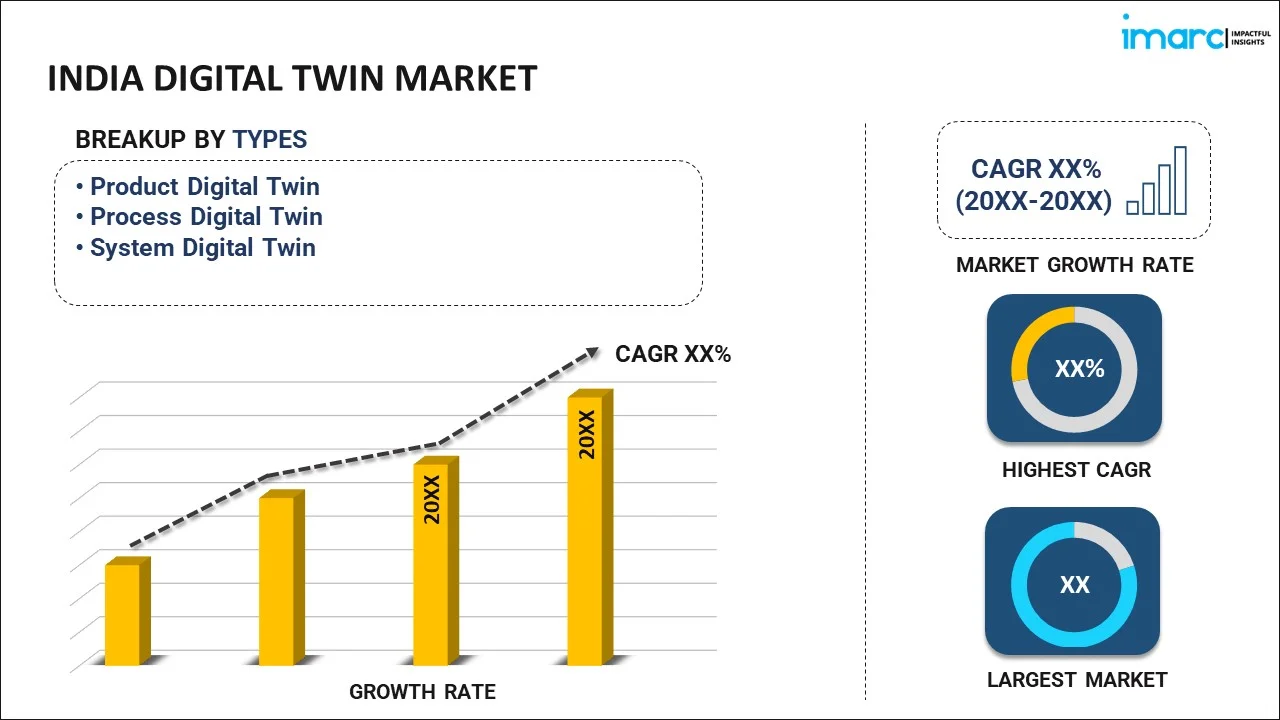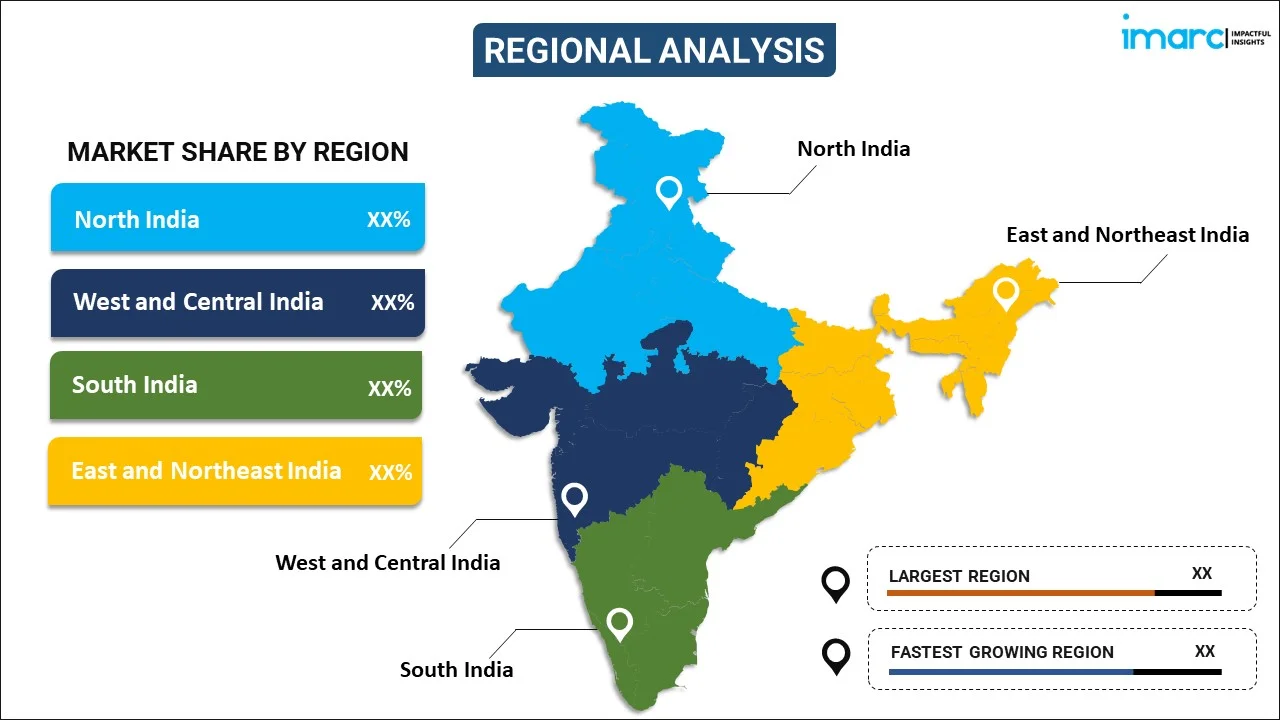
India Digital Twin Market Report by Type (Product Digital Twin, Process Digital Twin, System Digital Twin), Technology (IoT and IIoT, Blockchain, Artificial Intelligence and Machine Learning, Augmented Reality, Virtual Reality and Mixed Reality, Big Data Analytics, 5G), End Use (Aerospace and Defense, Automotive and Transportation, Healthcare, Energy and Utilities, Oil and Gas, Agriculture, Residential and Commercial, Retail and Consumer Goods, Telecommunication, and Others), and Region 2025-2033
Market Overview:
India digital twin market size reached USD 842.8 Million in 2024. Looking forward, IMARC Group expects the market to reach USD 16,644.3 Million by 2033, exhibiting a growth rate (CAGR) of 36.2% during 2025-2033. Numerous advancements in cloud computing technologies are primarily driving the market growth across the country.
|
Report Attribute
|
Key Statistics
|
|---|---|
|
Base Year
|
2024 |
|
Forecast Years
|
2025-2033 |
|
Historical Years
|
2019-2024
|
| Market Size in 2024 | USD 842.8 Million |
| Market Forecast in 2033 | USD 16,644.3 Million |
| Market Growth Rate (2025-2033) | 36.2% |
A digital twin is a computer-generated representation that mimics a physical object, system, or process through the utilization of computer programs, real-time data, simulations, and machine learning (ML) techniques. Designed to be an accurate duplicate with synchronized real-time data, digital twins act as a link between the tangible and virtual domains. These virtual replicas are generated using sensors that collect data from the physical environment and transmit it to their digital counterparts. This data is often augmented by high-fidelity simulation technology to forecast performance, enhance operational efficiency, and address challenges. Digital twins have become prominent across diverse industries, including manufacturing, healthcare, and urban planning, presenting a broad spectrum of applications ranging from optimizing machinery operations to implementing predictive maintenance in intricate systems.
India Digital Twin Market Trends:
The India digital twin market is witnessing substantial growth, signifying the country's increasing adoption of advanced technologies to bridge the gap between physical and digital realms. In manufacturing, the India digital twin market is making significant strides by optimizing operations and predicting performance. Additionally, digital twins play a pivotal role in enhancing efficiency, minimizing downtime, and streamlining processes, contributing to the evolution of smart manufacturing practices in the country. The healthcare sector in India is also leveraging this representation for applications such as patient monitoring and personalized treatment plans. Moreover, by creating virtual representations of biological systems, medical professionals can simulate and analyze scenarios, leading to improved patient outcomes and more precise interventions. By creating virtual models of cityscapes, urban planners can simulate the impact of different interventions and make informed decisions to improve public services and infrastructure, thereby acting as another significant growth-inducing factor. The India digital twin market is characterized by its multifaceted applications, ranging from predictive maintenance in complex systems to optimizing machine operations. Apart from this, as industries across India increasingly recognize the potential benefits of digital twins in enhancing performance and decision-making, the market is poised for continued growth and innovation, shaping the technological landscape of the country.
India Digital Twin Market Segmentation:
IMARC Group provides an analysis of the key trends in each segment of the market, along with forecasts at the country level for 2025-2033. Our report has categorized the market based on type, technology, and end use.
Type Insights:

- Product Digital Twin
- Process Digital Twin
- System Digital Twin
The report has provided a detailed breakup and analysis of the market based on the type. This includes product digital twin, process digital twin, and system digital twin.
Technology Insights:
- IoT and IIoT
- Blockchain
- Artificial Intelligence and Machine Learning
- Augmented Reality, Virtual Reality and Mixed Reality
- Big Data Analytics
- 5G
A detailed breakup and analysis of the market based on the technology have also been provided in the report. This includes IoT and IIoT, blockchain, artificial intelligence and machine learning, augmented reality, virtual reality and mixed reality, big data analytics, and 5G.
End Use Insights:
- Aerospace and Defense
- Automotive and Transportation
- Healthcare
- Energy and Utilities
- Oil and Gas
- Agriculture
- Residential and Commercial
- Retail and Consumer Goods
- Telecommunication
- Others
The report has provided a detailed breakup and analysis of the market based on the end use. This includes aerospace and defense, automotive and transportation, healthcare, energy and utilities, oil and gas, agriculture, residential and commercial, retail and consumer goods, telecommunication, and others.
Regional Insights:

- North India
- West and Central India
- South India
- East and Northeast India
The report has also provided a comprehensive analysis of all the major regional markets, which include North India, West and Central India, South India, and East and Northeast India.
Competitive Landscape:
The market research report has also provided a comprehensive analysis of the competitive landscape. Competitive analysis such as market structure, key player positioning, top winning strategies, competitive dashboard, and company evaluation quadrant has been covered in the report. Also, detailed profiles of all major companies have been provided.
India Digital Twin Market Report Coverage:
| Report Features | Details |
|---|---|
| Base Year of the Analysis | 2024 |
| Historical Period | 2019-2024 |
| Forecast Period | 2025-2033 |
| Units | Million USD |
| Scope of the Report | Exploration of Historical Trends and Market Outlook, Industry Catalysts and Challenges, Segment-Wise Historical and Future Market Assessment:
|
| Types Covered | Product Digital Twin, Process Digital Twin, System Digital Twin |
| Technologies Covered | IoT and IIoT, Blockchain, Artificial Intelligence and Machine Learning, Augmented Reality, Virtual Reality and Mixed Reality, Big Data Analytics, 5G |
| End Uses Covered | Aerospace and Defense, Automotive and Transportation, Healthcare, Energy and Utilities, Oil and Gas, Agriculture, Residential and Commercial, Retail and Consumer Goods, Telecommunication, Others |
| Regions Covered | North India, West and Central India, South India, East and Northeast India |
| Customization Scope | 10% Free Customization |
| Post-Sale Analyst Support | 10-12 Weeks |
| Delivery Format | PDF and Excel through Email (We can also provide the editable version of the report in PPT/Word format on special request) |
Key Questions Answered in This Report:
- How has the India digital twin market performed so far and how will it perform in the coming years?
- What has been the impact of COVID-19 on the India digital twin market?
- What is the breakup of the India digital twin market on the basis of type?
- What is the breakup of the India digital twin market on the basis of technology?
- What is the breakup of the India digital twin market on the basis of end use?
- What are the various stages in the value chain of the India digital twin market?
- What are the key driving factors and challenges in the India digital twin?
- What is the structure of the India digital twin market and who are the key players?
- What is the degree of competition in the India digital twin market?
Key Benefits for Stakeholders:
- IMARC’s industry report offers a comprehensive quantitative analysis of various market segments, historical and current market trends, market forecasts, and dynamics of the India digital twin market from 2019-2033.
- The research report provides the latest information on the market drivers, challenges, and opportunities in the India digital twin market.
- Porter's five forces analysis assist stakeholders in assessing the impact of new entrants, competitive rivalry, supplier power, buyer power, and the threat of substitution. It helps stakeholders to analyze the level of competition within the India digital twin industry and its attractiveness.
- Competitive landscape allows stakeholders to understand their competitive environment and provides an insight into the current positions of key players in the market.
Need more help?
- Speak to our experienced analysts for insights on the current market scenarios.
- Include additional segments and countries to customize the report as per your requirement.
- Gain an unparalleled competitive advantage in your domain by understanding how to utilize the report and positively impacting your operations and revenue.
- For further assistance, please connect with our analysts.
 Inquire Before Buying
Inquire Before Buying
 Speak to an Analyst
Speak to an Analyst
 Request Brochure
Request Brochure
 Request Customization
Request Customization




.webp)




.webp)












